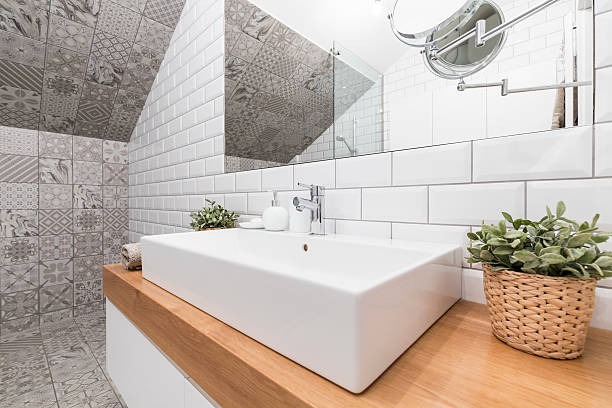From Clay Prep to Roller Kilns: How Ceramic Tiles Are Made
With a variety of designs and styles, ceramic tiles can add a unique touch to your home. However, how exactly are they made?
The most common fabrication method uses dust pressing, in which giant hydraulic machines press moist powder. This gives the tile dry strength and limits warpage as it dries. The pressed tile can also be decorated with engobes before firing.
Manufacturing Process
In a poetically shot video produced by Ceramic District, we see the natural raw materials of tile production being scooped up by excavators and poured into huge hoppers. The resulting clay minerals and other additives are blended, crushed and mixed into a powdered form ready for the next step. Thanks to innovation and research, these materials can now be combined with other mineral additions in ways that reduce energy consumption in the firing process.
The material is then weighed and dosed before being wet milled to guarantee complete homogenization. The grinding technique can be done either wet or dry, with a variety of milling machines being used including ball mills, muller or hammer mills. This grinding reduces the size of the materials to a level that can be easily pressed.
Once the powdered mix is prepared, it is then kneaded to remove any remaining air and to create a dense, even consistency. This kneading is also essential for producing tiles with a smooth, even surface that resists scratching and stains.
The most common fabrication method is dust pressing, in which giant hydraulic presses press the moist tile powder into flat tiles that can be as large as a meter square. This eliminates shrinkage during drying, so the finished product will be perfectly flat and true. Glazes and engobes can be applied to these tiles before their final firing.
Glazed Tile Production
The primary raw materials used to produce glazed ceramic tiles are clay minerals mined from the earth and other natural mineral additives such as feldspar to lower the firing temperature (Ceramic Research Company). The main component of clay is a hydrous aluminum silicate which possesses a plastic quality, meaning it can be shaped and molded into desired forms. The secondary raw materials are glaze and pigments which allow for the tile’s color, pattern and design.
The glazed tile manufacturing process begins with the initial grinding of the raw materials which is done by either a muller or roller mill which uses a squeezing motion between steel plates or a rotating motion between steel cones respectively to reduce larger lumps to smaller particles. The raw gach lat nen 100×100 materials then undergoes a drying process to remove the remaining moisture.
Once the body slip is dried out the next step is to apply a glaze to the surface of the tile. The glaze is made from a liquid mixture of a glass derivative called frit and colored dyes. The glaze fuses to the top surface of the tile in a high-temperature kiln during the ceramic tile firing process.
In order to ensure that the glazed tile is uniform and of high quality, it must undergo several additional processes. It must be polished to a sheen to provide a beautiful finish and it must be thoroughly inspected for any imperfections prior to being packaged for distribution.
Roller Kiln Tile Firing
While the super hero Peter Parker gets his powers from a radioactive spider and the Green Lantern gets a ring from a dying star, ceramic tile is powered by clay that’s formed, fired and glazed. Although different raw materials, procedures and manufacturing processes create different types of tiles, they all share one common characteristic: the porosity (water absorption) of their unglazed backs.
After a little dust pressing and some pre-firing in huge hydraulic presses, large batches of tiles are loaded into massive roller kilns. These new kilns are revolutionary because they speed up the firing process and eliminate warping caused by firing shrinkage. In fact, it’s the kiln technology that enabled tile to make the leap from wall tile only to floors and walls in homes, commercial buildings, hotels and other spaces.
In the kiln, the tile undergoes an extreme heat treatment. If the tile is going to be glazed, it goes through a glaze phase (step 4). This involves applying a thin layer of liquid glaze to the tiles and then drying them again under high temperatures in a controlled atmosphere.
The kilns can be heated by natural gas, oil or electricity. Depending on the fuel, the temperature in the kiln can reach up to 2,500 degrees Fahrenheit. To help the tile keep its shape while being heated, the manufacturer can insert conveyor belt-type contraptions into the kiln that move the tiles around.
Clay Preparation for Tiles
Step 1 starts with mining clay minerals and transforming them into sand. These sands are mixed with natural minerals like feldspar that help lower the firing temperature and chemical additives for shaping. The resulting mixture is then ground or crushed to produce smaller lumps. This can be done using a muller or hammer mills. Crushing is a messy and difficult task since it involves the use of steel hammers that can damage or even destroy the terra cotta clay.
Once the clay is in the right texture to create tilesit’s time for the next steps in ceramic tile making. First, technicians must design and draw the desired shape for a particular tile product. Sketches and templates can make the process a lot easier, especially when producing large scale tiles for home decor and artistic projects.
The resulting clay slabs must be shaped to the correct dimensions, and wedged to remove air bubbles. Once the tiles are shaped they must dry completely between drywall sheets to avert warpage. This is the most challenging part of the fabrication process. Technicians fight a constant battle against pinholes. One tiny pinhole can ruin an entire production run. Keeping the tiles flat throughout drying and the kiln firing is also very important.
When the tiles are ready they can be glazed. The glaze can be poured or spray-applied on the tiles. The glaze can be made from glass derivatives and colored dyes. The final step of the ceramic tile making process is to fire the tiles. The kiln is heated to around 2000 degrees Fahrenheit.











